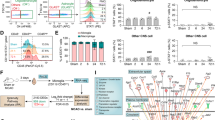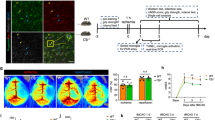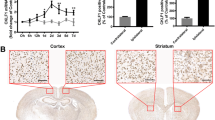Abstract
Microglia/macrophage activation plays an essential role in Ischemic stroke (IS). Nuclear receptor corepressor 1 (NCoR1) has been identified as a vital regulator in macrophages. The present study aims to explore the functions of macrophage NCoR1 in IS. Macrophage NCoR1 knockout (MNKO) mice and littermate control mice were subjected to middle cerebral artery occlusion (MCAO). Our data showed that macrophage NCoR1 deficiency significantly reduced the infarct size and infarct volume as well as brain edema after MCAO. Additionally, MNKO induced less microglia/macrophage infiltration and activation, neuroinflammation, apoptosis of neuronal cells, and BBB disruption in brains after IS. Mechanistic studies revealed that NCoR1 interacted with LXRβ in microglia and MNKO impaired the activation of the Nuclear factor-κB signaling pathway in brains after IS. Our data demonstrated that macrophage NCoR1 deficiency inhibited microglia/macrophage activation and protected against IS. Targeting NCoR1 in microglia/macrophage may be a potential approach for IS treatment.





Similar content being viewed by others
Abbreviations
- CNS:
-
Central nervous system
- IS:
-
Ischemic stroke
- MCAO:
-
Middle cerebral artery occlusion
- NCoR1:
-
Nuclear receptor corepressor1
- MNKO:
-
Macrophage NCoR1 knockout
- LC:
-
Littermate control
- TTC:
-
Triphenyl tetrazolium chloride
- Iba-1:
-
Ionized calcium binding adaptor molecule-1
- Tunnel:
-
Terminal deoxynucleotidyl transferase-mediated dUTP-biotin nick end labeling
- BBB:
-
Blood-brain barrier
- MMP-9:
-
Matrix metalloprotein-9
- ZO-1:
-
Zonula occludens 1
References
Campbell, B., De, S., Macleod, M., Coutts, S., Schwamm, L., Davis, S., et al. (2019). Ischaemic stroke. Nature Reviews. Disease Primers, 5(1), 70. https://doi.org/10.1038/s41572-019-0118-8.
Feigin, V., Nguyen, G., Cercy, K., Johnson, C., Alam, T., Parmar, P., et al. (2018). Global, regional, and country-specific lifetime risks of Stroke, 1990 and 2016. New England Journal of Medicine, 379(25), 2429–2437. https://doi.org/10.1056/NEJMoa1804492.
Phipps, M., & Cronin, C. (2020). Management of acute ischemic stroke. BMJ, 368, l6983. https://doi.org/10.1136/bmj.l6983.
Khandelwal, P., Yavagal, D., & Sacco, R. (2016). Acute ischemic stroke intervention. Journal of the American College of Cardiology, 67(22), 2631–2644. https://doi.org/10.1016/j.jacc.2016.03.555.
Fu, Y., Liu, Q., Anrather, J., & Shi, F. (2015). Immune interventions in stroke. Nature Reviews. Neurology, 11(9), 524–535. https://doi.org/10.1038/nrneurol.2015.144.
Wang, P., Shao, B., Deng, Z., Chen, S., Yue, Z., & Miao, C. (2018). Autophagy in ischemic stroke. Progress in Neurobiology, 163–164, 98–117. https://doi.org/10.1016/j.pneurobio.2018.01.001.
Jayaraj, R., Azimullah, S., Beiram, R., Jalal, F., & Rosenberg, G. (2019). Neuroinflammation: Friend and foe for ischemic stroke. Journal of Neuroinflammation, 16(1), 142. https://doi.org/10.1186/s12974-019-1516-2.
Ma, Y., Wang, J., Wang, Y., & Yang, G. (2017). The biphasic function of microglia in ischemic stroke. Progress in Neurobiology, 157, 247–272. https://doi.org/10.1016/j.pneurobio.2016.01.005.
Kanazawa, M., Ninomiya, I., Hatakeyama, M., Takahashi, T., & Shimohata, T. (2017). Microglia and monocytes/macrophages polarization reveal novel therapeutic mechanism against stroke. International Journal of Molecular Sciences, 18(10), 2135. https://doi.org/10.3390/ijms18102135.
García-Culebras, A., Durán-Laforet, V., Peña-Martínez, C., Ballesteros, I., Pradillo, J., Díaz-Guzmán, J., et al. (2018). Myeloid cells as therapeutic targets in neuroinflammation after stroke: Specific roles of neutrophils and neutrophil-platelet interactions. Journal of Cerebral Blood Flow and Metabolism, 38(12), 2150–2164. https://doi.org/10.1177/0271678X18795789.
Xiong, X., Liu, L., & Yang, Q. (2016). Functions and mechanisms of microglia/macrophages in neuroinflammation and neurogenesis after stroke. Progress in Neurobiology, 142, 23–44. https://doi.org/10.1016/j.pneurobio.2016.05.001.
Belov, K., Kriska, J., Tureckova, J., & Anderova, M. (2020). Ischemia-triggered glutamate excitotoxicity from the perspective of glial cells. Frontiers in Cellular Neuroscience, 14, 51. https://doi.org/10.3389/fncel.2020.00051.
Stoll, G., Jander, S., & Schroete, R. M. (1998). Inflammation and glial responses in ischemic brain lesions. Progress in Neurobiology, 56(2), 149–71. https://doi.org/10.1016/s0301-0082(98)00034-3.
Mottis, A., Mouchiroud, L., & Auwerx, J. (2013). Emerging roles of the corepressors NCoR1 and SMRT in homeostasis. Genes & Development, 27(8), 819–835. https://doi.org/10.1101/gad.214023.113.
Oppi, S., Nusser-Stein, S., Blyszczuk, P., Wang, X., Jomard, A., Marzolla, V., et al. (2020). Macrophage NCOR1 protects from atherosclerosis by repressing a pro-atherogenic PPARγ signature. European Heart Journal, 41(9), 995–1005. https://doi.org/10.1093/eurheartj/ehz667.
Saito, T., Kuma, A., Sugiura, Y., Ichimura, Y., Obata, M., Kitamura, H., et al. (2019). Autophagy regulates lipid metabolism through selective turnover of NCoR1. Nature Communications, 10(1), 1567. https://doi.org/10.1038/s41467-019-08829-3.
Jo, Y., Ryu, D., Maida, A., Wang, X., Evans, R. M., Schoonjans, K., et al. (2015). Phosphorylation of the nuclear receptor corepressor 1 by protein kinase B switches its corepressor targets in the liver in mice. Hepatology, 62(5), 1606–1618. https://doi.org/10.1002/hep.27907.
Li, C., Sun, X., Chen, B., Zeng, M., Du, L., Liu, T., et al. (2019). Nuclear receptor corepressor 1 represses cardiac hypertrophy. EMBO Molecular Medicine, 11(11), e9127. https://doi.org/10.15252/emmm.201809127.
Li, P., Spann, N., Kaikkonen, M., Lu, M., Oh, D., Fox, J., et al. (2013). NCoR repression of LXRs restricts macrophage biosynthesis of insulin-sensitizing omega 3 fatty acids. Cell, 155(1), 200–214. https://doi.org/10.1016/j.cell.2013.08.054.
Koellhoffer, E., & McCullough, L. (2012). The effects of estrogen in ischemic stroke. Translational Stroke Research, 4(4), 390–401. https://doi.org/10.1007/s12975-012-0230-5.
Belayev, L., Alonso, O., Busto, R., Zhao, W., & Ginsberg, M. (1996). Middle cerebral artery occlusion in the rat by intraluminal suture. Neurological and pathological evaluation of an improved model. Stroke, 27(9),1616–22; discussion 1623. https://doi.org/10.1161/01.str.27.9.1616.
Belayev, L., Hong, S., Freitas, R., Menghani, H., Marcell, S., Khoutorova, L., et al. (2020). DHA modulates MANF and TREM2 abundance, enhances neurogenesis, reduces infarct size, and improves neurological function after experimental ischemic stroke. CNS Neuroscience & Therapeutics, 26(11), 1155–1167. https://doi.org/10.1111/cns.13444.
Yang, J., Liu, C., Du, X., Liu, M., Ji, X., Du, H., et al. (2018). Hypoxia inducible factor 1α plays a key role in remote ischemic preconditioning against stroke by modulating inflammatory responses in rats. Journal of the American Heart Association, 7(5), e007589. https://doi.org/10.1161/JAHA.117.007589.
Du, L., Sun, J., Zhang, W., Wang, Y., Zhu, H., Liu, T., et al. (2020). Macrophage NCOR1 deficiency ameliorates myocardial infarction and neointimal hyperplasia in mice. Journal of the American Heart Association, 9(15), e015862. https://doi.org/10.1161/JAHA.120.015862.
Sillerud, L., Yang, Y., Yang, L., Duval, K., Thompson, J., & Yang, Y. (2020). Longitudinal monitoring of microglial/macrophage activation in ischemic rat brain using Iba-1-specific nanoparticle-enhanced magnetic resonance imaging. Journal of Cerebral Blood Flow and Metabolism, 40(1_suppl), S117–S133. https://doi.org/10.1177/0271678X20953913.
Ding, L., Xu, X., Li, C., Wang, Y., Xia, X., & Zheng, J. (2021). Glutaminase in microglia: A novel regulator of neuroinflammation. Brain, Behavior, and Immunity, 92, 139–156. https://doi.org/10.1016/j.bbi.2020.11.038.
Li, T., Zhao, J., Xie, W., Yuan, W., Guo, J., Pang, S., et al. (2021). Specific depletion of resident microglia in the early stage of stroke reduces cerebral ischemic damage. Journal of Neuroinflammation, 18(1), 81. https://doi.org/10.1186/s12974-021-02127-w.
Lu, Y., Li, C., Chen, Q., Liu, P., Guo, Q., Zhang, Y., et al. (2019). Microthrombus-targeting micelles for neurovascular remodeling and enhanced microcirculatory perfusion in acute ischemic stroke. Advanced Materials, 31(21), e1808361. https://doi.org/10.1002/adma.201808361.
Wang, D., Liu, F., Zhu, L., Lin, P., Han, F., Wang, X., et al. (2020). FGF21 alleviates neuroinflammation following ischemic stroke by modulating the temporal and spatial dynamics of microglia/macrophages. Journal of Neuroinflammation, 17(1), 257. https://doi.org/10.1186/s12974-020-01921-2.
Liu, Z., Ran, Y., Qie, S., Gong, W., Gao, F., Ding, Z., et al. (2019). Melatonin protects against ischemic stroke by modulating microglia/macrophage polarization toward anti-inflammatory phenotype through STAT3 pathway. CNS Neuroscience & Therapeutics, 25(12), 1353–1362. https://doi.org/10.1111/cns.13261.
Jian, Z., Liu, R., Zhu, X., Smerin, D., Zhong, Y., Gu, L., et al. (2019). The involvement and therapy target of immune cells after ischemic stroke. Frontiers in Immunology, 10, 2167. https://doi.org/10.3389/fimmu.2019.02167.
Frieler, R., Meng, H., Duan, S., Berger, S., Schütz, G., He, Y., et al. (2011). Myeloid-specific deletion of the mineralocorticoid receptor reduces infarct volume and alters inflammation during cerebral ischemia. Stroke, 42(1), 179–185. https://doi.org/10.1161/STROKEAHA.110.598441.
Cho, I., Hong, J., Suh, E., Kim, J., Lee, H., Lee, J., et al. (2008). Role of microglial IKKbeta in kainic acid-induced hippocampal neuronal cell death. Brain, 131(Pt 11), 3019–3033. https://doi.org/10.1093/brain/awn230.
Zhang-Gandhi, C., & Drew, P. (2007). Liver X receptor and retinoid X receptor agonists inhibit inflammatory responses of microglia and astrocytes. Journal of Neuroimmunology, 183(1–2), 50–59. https://doi.org/10.1016/j.jneuroim.2006.11.007.
Zhu, Q., Tang, T., Liu, H., Sun, Y., Wang, X., Liu, Q., et al. (2020). pterostilbene attenuates cocultured BV-2 microglial inflammation-mediated SH-SY5Y neuronal oxidative injury via SIRT-1 signalling. Oxidative Medicine and Cellular Longevity, 2020, 3986348. https://doi.org/10.1155/2020/3986348.
Petroff, O. (2002). GABA and glutamate in the human brain. The Neuroscientist, 8(6), 562–573. https://doi.org/10.1177/1073858402238515.
Lee, W., Ham, S., Yoo, H., Hwang, J., Yoo, T., Paek, K., et al. (2018). Activation of PPARδ attenuates neurotoxicity by inhibiting lipopolysaccharide-triggered glutamate release in BV-2 microglial cells. Journal of Cellular Biochemistry, 119(7), 5609–5619. https://doi.org/10.1002/jcb.26732.
Sweeney, M., Zhao, Z., Montagne, A., Nelson, A., & Zlokovic, B. (2019). Blood-brain barrier: From physiology to disease and back. Physiological Reviews, 99(1), 21–78. https://doi.org/10.1152/physrev.00050.2017.
Chaturvedi, M., & Kaczmarek, L. (2014). Mmp-9 inhibition: A therapeutic strategy in ischemic stroke. Molecular Neurobiology, 49(1), 563–573. https://doi.org/10.1007/s12035-013-8538-z.
Chen, A., Fang, Z., Chen, X., Yang, S., Zhou, Y., Mao, L., et al. (2019). Microglia-derived TNF-α mediates endothelial necroptosis aggravating blood brain-barrier disruption after ischemic stroke. Cell Death & Disease, 10(7), 487. https://doi.org/10.1038/s41419-019-1716-9.
Yang, Y., Salayandia, V., Thompson, J., Yang, L., Estrada, E., & Yang, Y. (2015). Attenuation of acute stroke injury in rat brain by minocycline promotes blood-brain barrier remodeling and alternative microglia/macrophage activation during recovery. Journal of Neuroinflammation, 12, 26. https://doi.org/10.1186/s12974-015-0245-4.
Cui, J., Chen, S., Zhang, C., Meng, F., Wu, W., Hu, R., et al. (2012). Inhibition of MMP-9 by a selective gelatinase inhibitor protects neurovasculature from embolic focal cerebral ischemia. Molecular Neurodegeneration, 7, 21. https://doi.org/10.1186/1750-1326-7-21.
Funding
This work was supported by grants from the National Natural Science Foundation of China (81971093, 81725003, 31900810, 81900227), Science and Technology Commission of Shanghai Municipal (21ZR1439000), and Innovative Research Team of High-Level Local Universities in Shanghai.
Author information
Authors and Affiliations
Corresponding author
Ethics declarations
Ethics Approval
All applicable international, national, and/or institutional guidelines for the care and use of animals were followed. This article does not contain any studies with humans performed by any of the authors.
Conflict of Interest
The authors declare no competing interest.
Additional information
Associate Editor Junjie Xiao oversaw the review of this article
Publisher's Note
Springer Nature remains neutral with regard to jurisdictional claims in published maps and institutional affiliations.
Supplementary Information
Below is the link to the electronic supplementary material.
Rights and permissions
About this article
Cite this article
Shao, S., Chen, YL., Du, LJ. et al. Macrophage Nuclear Receptor Corepressor 1 Deficiency Protects Against Ischemic Stroke in Mice. J. of Cardiovasc. Trans. Res. 15, 816–827 (2022). https://doi.org/10.1007/s12265-021-10187-9
Received:
Accepted:
Published:
Issue Date:
DOI: https://doi.org/10.1007/s12265-021-10187-9




